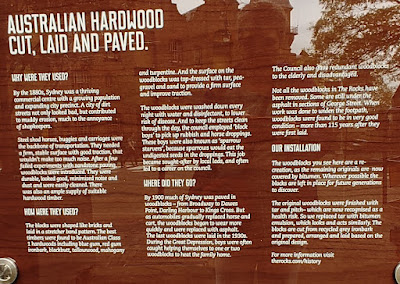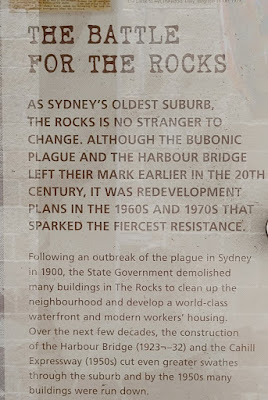 |
| The tour started at the Clock Tower |
 |
| Go to The Rocks website |
 |
| The Suez Canal narrowed as it went downhill |
 |
| Many of the building still had pulley hoists from the days when supplies were stored in the attic. |
 |
| Go to The Rocks Website to see what it had to say about the Reynold's Cottages. |
 |
| How the walkways were constructed. |
 |
| Click to enlarge to read about Franis Greenway, convict architect who designed many buildings that are still standing in The Rocks. |
 |
| Timeline of some of the buildings he designed. |
 |
| More info on Francis Greenway. |
 |
| Gannon House is an historic building designed and built by Michael Gannon from 1839 to 1840 as residential houses and stables. |
 |
| The city has placed some informative signs along some of the main throughfares. |
 |
| Decorative artwork outside The Rocks Discovery Museum. |
 |
| We have two things here, a closeup of the construction of the building and an aboriginal word. |
 |
| Sorry, this is so hard to read but it relays the era of the Green Bans, a series of worker boycotts of projects that would have destroyed many historically important sites in the city. Go to Sydney’s Green Bans: the worker boycotts that saved the city – Lives and Times (livesandtimesblog.com) to learn about this interesting time in Sydney's history. |
 |
| This mural is along Kendall Lane. Read the following photos to learn about it. |
 |
| From the mural we headed downhill into the back alley between Kendall Lane and George Street. |
 |
| See the plaque on the wall? |
 |
| 77 George Street, current location of The Doss House whiskey bar, has had many different uses. Business located there have included a boot maker, a boarding house, and an opium dealer. |
 |
| George Street looking downtown. |
 |
| One of the rare addresses which make you think of the Harry Potter movies. |
 |
| This picture shows just how close the shore is and how deep the water must be. Yes, that's a cruise ship. |
 |
| We saw some phone booths too. Most didn't look like this; they just had an overhanging roof. Not sure about this one, but the others offered wi-fi service. |
 |
| Corner of George and Hickson, looking northwest on George Street. |
 |
| Section of the street paved with wooden blocks. |
 |
| Very interesting information on why wood blocks were laid and what happened to them. Actually, some are still under the asphalt. |
 |
| Now that's a steep penalty. |
 |
| From George Street we walked up Mill Lane, where water ran alongside the steps. |
 |
| At the top we could see where water gushed out of the pavement. I never did find out about why this happens. |
 |
| Then we mounted the steps along the building we had come through. They crossed over the gap to the top of the rocks. |
 |
| On top looking back down. |
 |
| We liked the red sign about racism. |
 |
| Crosswalk signs are a bit different in Australia. |
 |
| Another typical look of a pickup in Australia |
 |
| Lovely garden area down by Circular Quay. |
 |
| Once we got on Harrington Street we had to take a short jog to the right to continue up some more steps. On the rock wall to the left of the steps is a small statue. |
 |
| This sculpture, created by Leonie Rhodes, is called ‘Child of The Rocks’. |
 |
| Old sandstone steps leading from Harrington Street to Cambridge Street. |
 |
| Before we headed up the Cumberland Steps, we were on Cambridge Street. |
 |
| We continued up the Cumberland Steps to Cumberland Street. |
 |
| And back to the YHA. A note on the Whalers Arms. It was a hotel in The Rocks. You can read all about it at the following website, https://www.visitsydneyaustralia.com.au/rocks-pubs.html |









































No comments:
Post a Comment